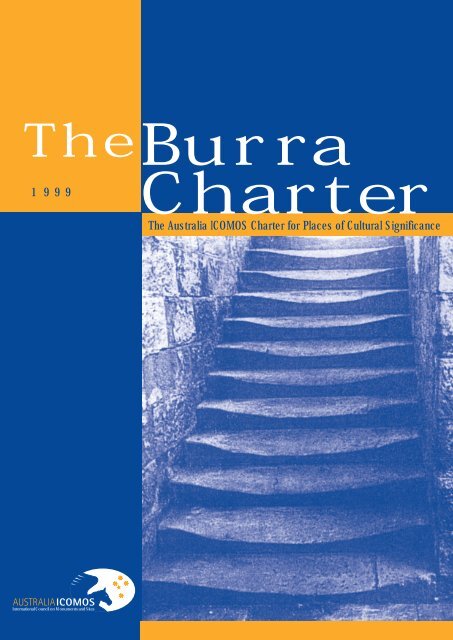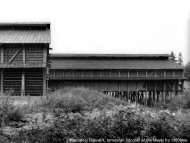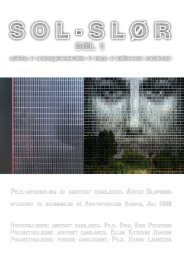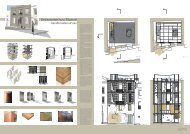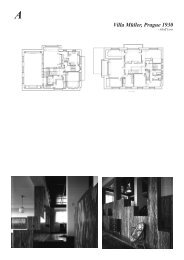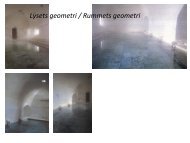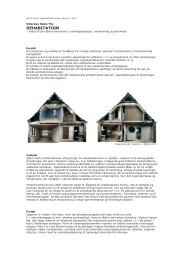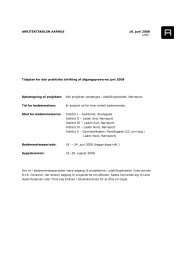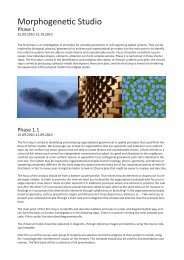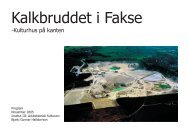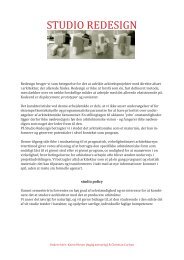The Australia ICOMOS Charter for Places of Cultural Significance 1 ...
The Australia ICOMOS Charter for Places of Cultural Significance 1 ...
The Australia ICOMOS Charter for Places of Cultural Significance 1 ...
You also want an ePaper? Increase the reach of your titles
YUMPU automatically turns print PDFs into web optimized ePapers that Google loves.
<strong>The</strong> Burra <strong>Charter</strong><br />
<strong>The</strong> <strong>Australia</strong> <strong>ICOMOS</strong> <strong>Charter</strong> <strong>for</strong> <strong>Places</strong> <strong>of</strong> <strong>Cultural</strong> <strong>Significance</strong><br />
1 9 9 9<br />
International Council on Monuments and Sites
<strong>The</strong><br />
B u r r a<br />
<strong>Charter</strong><br />
<strong>The</strong> <strong>Australia</strong> <strong>ICOMOS</strong> <strong>Charter</strong> <strong>for</strong> <strong>Places</strong><br />
<strong>of</strong> <strong>Cultural</strong> <strong>Significance</strong> 1999<br />
with associated Guidelines and Code on the<br />
Ethics <strong>of</strong> Co-existence<br />
<strong>Australia</strong> <strong>ICOMOS</strong> Inc<br />
International Council <strong>of</strong> Monuments and Sites
© <strong>Australia</strong> <strong>ICOMOS</strong> Incorporated 2000<br />
Permission is granted to reproduce part or<br />
all <strong>of</strong> this publication <strong>for</strong> non-commercial<br />
purposes provided the source is<br />
acknowledged.<br />
Cover photograph by Ian Stapleton.<br />
Published by <strong>Australia</strong> <strong>ICOMOS</strong><br />
Incorporated<br />
<strong>Australia</strong> <strong>ICOMOS</strong> Secretariat<br />
c /o Faculty <strong>of</strong> Arts<br />
Deakin University<br />
Burwood VIC 3125<br />
<strong>Australia</strong><br />
www.icomos.org/australia<br />
<strong>Australia</strong> <strong>ICOMOS</strong> gratefully<br />
acknowledges the assistance <strong>of</strong> the<br />
<strong>Australia</strong>n Heritage Commission and the<br />
Department <strong>of</strong> Communications and the<br />
Arts (now Department <strong>of</strong><br />
Communications In<strong>for</strong>mation Technology<br />
and the Arts) with the preparation and<br />
publication <strong>of</strong> this document.<br />
National Library <strong>of</strong> <strong>Australia</strong> cataloguingin-publication<br />
data:<br />
<strong>The</strong> Burra <strong>Charter</strong>: the <strong>Australia</strong><br />
<strong>ICOMOS</strong> <strong>Charter</strong> <strong>for</strong> <strong>Places</strong> <strong>of</strong> <strong>Cultural</strong><br />
<strong>Significance</strong>.<br />
ISBN 0 9578528 0 0<br />
1. <strong>Cultural</strong> property - Protection -<br />
<strong>Australia</strong>. 2. Historic sites - <strong>Australia</strong> -<br />
Conservation and restoration. 3. Historic<br />
buildings - <strong>Australia</strong> - Conservation and<br />
restoration. 4. Monuments - <strong>Australia</strong> -<br />
Conservation and restoration.<br />
363 690994
contents<br />
<strong>The</strong> Burra <strong>Charter</strong>, 1999 1<br />
Guidelines to the Burra <strong>Charter</strong>: <strong>Cultural</strong> <strong>Significance</strong>, 1988 11<br />
Guidelines to the Burra <strong>Charter</strong>: Conservation Policy, 1988 14<br />
Guidelines to the Burra <strong>Charter</strong>: Procedures <strong>for</strong> Undertaking<br />
Studies and Reports, 1988 18<br />
Code on the Ethics <strong>of</strong> Co-existence in Conserving<br />
Significant <strong>Places</strong>, 1998 20<br />
Notes on the 1999 revisions to the Burra <strong>Charter</strong> 22<br />
Conversion table: Burra <strong>Charter</strong>, 1999 and previous version 23
<strong>ICOMOS</strong><br />
<strong>ICOMOS</strong> (International Council on Monuments and<br />
Sites) is a non-governmental pr<strong>of</strong>essional organisation<br />
<strong>for</strong>med in 1965, with headquarters in Paris. <strong>ICOMOS</strong> is<br />
primarily concerned with the philosophy, terminology,<br />
methodology and techniques <strong>of</strong> cultural heritage<br />
conservation. It is closely linked to UNESCO,<br />
particularly in its role under the World Heritage<br />
Convention 1972 as UNESCO’s principal adviser on<br />
cultural matters related to World Heritage. <strong>The</strong> 5,000<br />
members <strong>of</strong> <strong>ICOMOS</strong> include architects, town planners,<br />
demographers, archaeologists, geographers, historians,<br />
conservators, anthropologists and heritage administrators.<br />
Members in the 84 countries belonging to <strong>ICOMOS</strong> are<br />
<strong>for</strong>med into National Committees and participate in a<br />
range <strong>of</strong> conservation projects, research work, intercultural<br />
exchanges and cooperative activities. <strong>ICOMOS</strong> also has a<br />
number <strong>of</strong> International Scientific Committees that focus<br />
on particular aspects <strong>of</strong> the conservation field. <strong>The</strong><br />
members meet triennially in a General Assembly.<br />
<strong>Australia</strong> <strong>ICOMOS</strong> Inc.<br />
<strong>The</strong> <strong>Australia</strong>n National Committee <strong>of</strong> <strong>ICOMOS</strong><br />
(<strong>Australia</strong> <strong>ICOMOS</strong> Inc.) was <strong>for</strong>med in 1976. It elects<br />
an Executive Committee <strong>of</strong> 15 members, which is<br />
responsible <strong>for</strong> carrying out national programs and<br />
participating in decisions <strong>of</strong> <strong>ICOMOS</strong> as an international<br />
organisation. It provides expert advice as required by<br />
<strong>ICOMOS</strong>, especially in its relationship with the World<br />
heritage Committee. <strong>Australia</strong> <strong>ICOMOS</strong> acts as a national<br />
and international link between public authorities,<br />
institutions and individuals involved in the study and<br />
conservation <strong>of</strong> all places <strong>of</strong> cultural significance. <strong>Australia</strong><br />
<strong>ICOMOS</strong> members participate in a range <strong>of</strong> conservation<br />
activities including site visits, training, conferences and<br />
meetings.<br />
Revision <strong>of</strong> the Burra <strong>Charter</strong><br />
<strong>The</strong> Burra <strong>Charter</strong> was first adopted in 1979 at the<br />
historic South <strong>Australia</strong>n mining town <strong>of</strong> Burra; minor<br />
revisions were made in 1981 and 1988. Following a five<br />
year review, more substantial changes were made resulting<br />
in this version which was adopted by <strong>Australia</strong> <strong>ICOMOS</strong><br />
in November 1999. All <strong>Australia</strong> <strong>ICOMOS</strong> documents<br />
are regularly reviewed and <strong>Australia</strong> <strong>ICOMOS</strong> welcomes<br />
any comments.<br />
This booklet also contains the three Guidelines to the<br />
Burra <strong>Charter</strong> and the Code on the Ethics <strong>of</strong> Coexistence.<br />
<strong>The</strong>se have yet to be revised to accord with the<br />
1999 <strong>Charter</strong>, but are included here <strong>for</strong> completeness.<br />
<strong>Australia</strong> <strong>ICOMOS</strong> plans to update them with the aim <strong>of</strong><br />
completing a consistent suite <strong>of</strong> documents when the<br />
<strong>Charter</strong> itself is next reviewed.<br />
To assist those familiar with previous versions <strong>of</strong> the<br />
<strong>Charter</strong>, this booklet also contains some notes explaining<br />
the key changes made and a conversion table relating<br />
articles in the 1999 <strong>Charter</strong> to those <strong>of</strong> the previous<br />
version.<br />
Important Note<br />
<strong>The</strong> 1988 version <strong>of</strong> the Burra <strong>Charter</strong> has now been<br />
superseded and joins the 1981 and 1979 versions as<br />
archival documents recording the development <strong>of</strong><br />
conservation philosophy in <strong>Australia</strong>.<br />
Citing the Burra <strong>Charter</strong><br />
<strong>The</strong> full reference is <strong>The</strong> Burra <strong>Charter</strong>: <strong>The</strong> <strong>Australia</strong><br />
<strong>ICOMOS</strong> <strong>Charter</strong> <strong>for</strong> <strong>Places</strong> <strong>of</strong> <strong>Cultural</strong> <strong>Significance</strong> 1999.<br />
Initial textual references should be in the <strong>for</strong>m <strong>of</strong> the<br />
<strong>Australia</strong> <strong>ICOMOS</strong> Burra <strong>Charter</strong>, 1999 and later<br />
references in the short <strong>for</strong>m (Burra <strong>Charter</strong>).
<strong>The</strong> Burra <strong>Charter</strong><br />
(<strong>The</strong> <strong>Australia</strong> <strong>ICOMOS</strong> <strong>Charter</strong> <strong>for</strong> <strong>Places</strong> <strong>of</strong> <strong>Cultural</strong> <strong>Significance</strong>)<br />
Preamble<br />
Considering the International <strong>Charter</strong> <strong>for</strong> the<br />
Conservation and Restoration <strong>of</strong> Monuments and Sites<br />
(Venice 1964), and the Resolutions <strong>of</strong> the 5th General<br />
Assembly <strong>of</strong> the International Council on Monuments<br />
and Sites (<strong>ICOMOS</strong>) (Moscow 1978), the Burra <strong>Charter</strong><br />
was adopted by <strong>Australia</strong> <strong>ICOMOS</strong> (the <strong>Australia</strong>n<br />
National Committee <strong>of</strong> <strong>ICOMOS</strong>) on 19 August 1979 at<br />
Burra, South <strong>Australia</strong>. Revisions were adopted on 23<br />
February 1981, 23 April 1988 and 26 November 1999.<br />
<strong>The</strong> Burra <strong>Charter</strong> provides guidance <strong>for</strong> the conservation<br />
and management <strong>of</strong> places <strong>of</strong> cultural significance<br />
(cultural heritage places), and is based on the knowledge<br />
and experience <strong>of</strong> <strong>Australia</strong> <strong>ICOMOS</strong> members.<br />
Conservation is an integral part <strong>of</strong> the management <strong>of</strong><br />
places <strong>of</strong> cultural significance and is an ongoing<br />
responsibility.<br />
Who is the <strong>Charter</strong> <strong>for</strong>?<br />
<strong>The</strong> <strong>Charter</strong> sets a standard <strong>of</strong> practice <strong>for</strong> those who<br />
provide advice, make decisions about, or undertake works<br />
to places <strong>of</strong> cultural significance, including owners,<br />
managers and custodians.<br />
Using the <strong>Charter</strong><br />
<strong>The</strong> <strong>Charter</strong> should be read as a whole. Many articles are<br />
interdependent. Articles in the Conservation Principles<br />
section are <strong>of</strong>ten further developed in the Conservation<br />
Processes and Conservation Practice sections. Headings<br />
have been included <strong>for</strong> ease <strong>of</strong> reading but do not <strong>for</strong>m<br />
part <strong>of</strong> the <strong>Charter</strong>.<br />
<strong>The</strong> <strong>Charter</strong> is self-contained, but aspects <strong>of</strong> its use and<br />
application are further explained in the following <strong>Australia</strong><br />
<strong>ICOMOS</strong> documents:<br />
• Guidelines to the Burra <strong>Charter</strong>: <strong>Cultural</strong><br />
<strong>Significance</strong>;<br />
• Guidelines to the Burra <strong>Charter</strong>: Conservation Policy;<br />
• Guidelines to the Burra <strong>Charter</strong>: Procedures <strong>for</strong><br />
Undertaking Studies and Reports;<br />
• Code on the Ethics <strong>of</strong> Coexistence in Conserving<br />
Significant <strong>Places</strong>.<br />
What places does the <strong>Charter</strong> apply to?<br />
<strong>The</strong> <strong>Charter</strong> can be applied to all types <strong>of</strong> places <strong>of</strong><br />
cultural significance including natural, indigenous and<br />
historic places with cultural values.<br />
<strong>The</strong> standards <strong>of</strong> other organisations may also be relevant.<br />
<strong>The</strong>se include the <strong>Australia</strong>n Natural Heritage <strong>Charter</strong><br />
and the Draft Guidelines <strong>for</strong> the Protection, Management<br />
and Use <strong>of</strong> Aboriginal and Torres Strait Islander <strong>Cultural</strong><br />
Heritage <strong>Places</strong>.<br />
Why conserve?<br />
<strong>Places</strong> <strong>of</strong> cultural significance enrich people’s lives, <strong>of</strong>ten<br />
providing a deep and inspirational sense <strong>of</strong> connection to<br />
community and landscape, to the past and to lived<br />
experiences. <strong>The</strong>y are historical records, that are important<br />
as tangible expressions <strong>of</strong> <strong>Australia</strong>n identity and<br />
experience. <strong>Places</strong> <strong>of</strong> cultural significance reflect the<br />
diversity <strong>of</strong> our communities, telling us about who we are<br />
and the past that has <strong>for</strong>med us and the <strong>Australia</strong>n<br />
landscape. <strong>The</strong>y are irreplaceable and precious.<br />
<strong>The</strong>se places <strong>of</strong> cultural significance must be conserved <strong>for</strong><br />
present and future generations.<br />
<strong>The</strong> Burra <strong>Charter</strong> advocates a cautious approach to<br />
change: do as much as necessary to care <strong>for</strong> the place and<br />
to make it useable, but otherwise change it as little as<br />
possible so that its cultural significance is retained.<br />
<strong>The</strong> Burra <strong>Charter</strong>, 1999<br />
<strong>Australia</strong> <strong>ICOMOS</strong> I n c<br />
1
Articles<br />
Explanatory Notes<br />
Article 1. Definitions<br />
For the purposes <strong>of</strong> this <strong>Charter</strong>:<br />
1.1 Place means site, area, land, landscape, building or other work, group <strong>of</strong><br />
buildings or other works, and may include components, contents, spaces<br />
and views.<br />
1.2 <strong>Cultural</strong> significance means aesthetic, historic, scientific, social or spiritual<br />
value <strong>for</strong> past, present or future generations.<br />
<strong>Cultural</strong> significance is embodied in the place itself, its fabric, setting, use,<br />
associations, meanings, records, related places and related objects.<br />
<strong>Places</strong> may have a range <strong>of</strong> values <strong>for</strong> different individuals or groups.<br />
1.3 Fabric means all the physical material <strong>of</strong> the place including components,<br />
fixtures, contents, and objects.<br />
1.4 Conservation means all the processes <strong>of</strong> looking after a place so as to retain<br />
its cultural significance.<br />
1.5 Maintenance means the continuous protective care <strong>of</strong> the fabric and<br />
setting <strong>of</strong> a place, and is to be distinguished from repair. Repair involves<br />
restoration or reconstruction.<br />
1.6 Preservation means maintaining the fabric <strong>of</strong> a place in its existing state<br />
and retarding deterioration.<br />
1.7 Restoration means returning the existing fabric <strong>of</strong> a place to a known<br />
earlier state by removing accretions or by reassembling existing<br />
components without the introduction <strong>of</strong> new material.<br />
1.8 Reconstruction means returning a place to a known earlier state and is<br />
distinguished from restoration by the introduction <strong>of</strong> new material into<br />
the fabric.<br />
<strong>The</strong> concept <strong>of</strong> place should be broadly<br />
interpreted. <strong>The</strong> elements described in Article<br />
1.1 may include memorials, trees, gardens,<br />
parks, places <strong>of</strong> historical events, urban areas,<br />
towns, industrial places, archaeological sites<br />
and spiritual and religious places.<br />
<strong>The</strong> term cultural significance is synonymous<br />
with heritage significance and cultural<br />
heritage value.<br />
<strong>Cultural</strong> significance may change as a result<br />
<strong>of</strong> the continuing history <strong>of</strong> the place.<br />
Understanding <strong>of</strong> cultural significance may<br />
change as a result <strong>of</strong> new in<strong>for</strong>mation.<br />
Fabric includes building interiors and subsurface<br />
remains, as well as excavated material.<br />
Fabric may define spaces and these may be<br />
important elements <strong>of</strong> the significance <strong>of</strong><br />
the place.<br />
<strong>The</strong> distinctions referred to, <strong>for</strong> example in<br />
relation to ro<strong>of</strong> gutters, are:<br />
• maintenance — regular inspection and<br />
cleaning <strong>of</strong> gutters;<br />
• repair involving restoration — returning<br />
<strong>of</strong> dislodged gutters;<br />
• repair involving reconstruction —<br />
replacing decayed gutters.<br />
It is recognised that all places and their<br />
components change over time at varying<br />
rates.<br />
New material may include recycled material<br />
salvaged from other places. This should not<br />
be to the detriment <strong>of</strong> any place <strong>of</strong> cultural<br />
significance.<br />
1 . 9 Adaptation means modifying a place to suit the existing use or a proposed use.<br />
1.10 Use means the functions <strong>of</strong> a place, as well as the activities and practices<br />
that may occur at the place.<br />
1.11 Compatible use means a use which respects the cultural significance <strong>of</strong> a<br />
place. Such a use involves no, or minimal, impact on cultural significance.<br />
1.12 Setting means the area around a place, which may include the visual<br />
catchment.<br />
1.13 Related place means a place that contributes to the cultural significance <strong>of</strong><br />
another place.<br />
2 <strong>Australia</strong> <strong>ICOMOS</strong> I n c <strong>The</strong> Burra <strong>Charter</strong>, 1999
Articles<br />
Explanatory Notes<br />
1.14 Related object means an object that contributes to the cultural significance<br />
<strong>of</strong> a place but is not at the place.<br />
1.15 Associations mean the special connections that exist between people and<br />
a place.<br />
Associations may include social or spiritual<br />
values and cultural responsibilities <strong>for</strong> a place.<br />
1.16 Meanings denote what a place signifies, indicates, evokes or expresses. Meanings generally relate to intangible<br />
aspects such as symbolic qualities and<br />
memories.<br />
1.17 Interpretation means all the ways <strong>of</strong> presenting the cultural significance <strong>of</strong><br />
a place.<br />
Conservation Principles<br />
Interpretation may be a combination <strong>of</strong> the<br />
treatment <strong>of</strong> the fabric (e.g. maintenance,<br />
restoration, reconstruction); the use <strong>of</strong> and<br />
activities at the place; and the use <strong>of</strong><br />
introduced explanatory material.<br />
Article 2. Conservation and management<br />
2.1 <strong>Places</strong> <strong>of</strong> cultural significance should be conserved.<br />
2.2 <strong>The</strong> aim <strong>of</strong> conservation is to retain the cultural significance <strong>of</strong> a place.<br />
2.3 Conservation is an integral part <strong>of</strong> good management <strong>of</strong> places <strong>of</strong> cultural<br />
significance.<br />
2.4 <strong>Places</strong> <strong>of</strong> cultural significance should be safeguarded and not put at risk or<br />
left in a vulnerable state.<br />
Article 3. Cautious approach<br />
3.1 Conservation is based on a respect <strong>for</strong> the existing fabric, use, associations<br />
and meanings. It requires a cautious approach <strong>of</strong> changing as much as<br />
necessary but as little as possible.<br />
<strong>The</strong> traces <strong>of</strong> additions, alterations and earlier<br />
treatments to the fabric <strong>of</strong> a place are<br />
evidence <strong>of</strong> its history and uses which may be<br />
part <strong>of</strong> its significance. Conservation action<br />
should assist and not impede their<br />
understanding.<br />
3.2 Changes to a place should not distort the physical or other evidence it<br />
provides, nor be based on conjecture.<br />
Article 4. Knowledge, skills and techniques<br />
4.1 Conservation should make use <strong>of</strong> all the knowledge, skills and disciplines<br />
which can contribute to the study and care <strong>of</strong> the place.<br />
4.2 Traditional techniques and materials are preferred <strong>for</strong> the conservation <strong>of</strong><br />
significant fabric. In some circumstances modern techniques and materials<br />
which <strong>of</strong>fer substantial conservation benefits may be appropriate.<br />
<strong>The</strong> use <strong>of</strong> modern materials and techniques<br />
must be supported by firm scientific evidence<br />
or by a body <strong>of</strong> experience.<br />
<strong>The</strong> Burra <strong>Charter</strong>, 1999<br />
<strong>Australia</strong> <strong>ICOMOS</strong> I n c<br />
3
Articles<br />
Explanatory Notes<br />
Article 5. Values<br />
5.1 Conservation <strong>of</strong> a place should identify and take into consideration all<br />
aspects <strong>of</strong> cultural and natural significance without unwarranted emphasis<br />
on any one value at the expense <strong>of</strong> others.<br />
5.2 Relative degrees <strong>of</strong> cultural significance may lead to different conservation<br />
actions at a place.<br />
Article 6. Burra <strong>Charter</strong> process<br />
6.1 <strong>The</strong> cultural significance <strong>of</strong> a place and other issues affecting its future are<br />
best understood by a sequence <strong>of</strong> collecting and analysing in<strong>for</strong>mation<br />
be<strong>for</strong>e making decisions. Understanding cultural significance comes first,<br />
then development <strong>of</strong> policy and finally management <strong>of</strong> the place in<br />
accordance with the policy.<br />
Conservation <strong>of</strong> places with natural<br />
significance is explained in the <strong>Australia</strong>n<br />
Natural Heritage <strong>Charter</strong>. This <strong>Charter</strong><br />
defines natural significance to mean the<br />
importance <strong>of</strong> ecosystems, biological diversity<br />
and geodiversity <strong>for</strong> their existence value, or<br />
<strong>for</strong> present or future generations in terms <strong>of</strong><br />
their scientific, social, aesthetic and lifesupport<br />
value.<br />
A cautious approach is needed, as<br />
understanding <strong>of</strong> cultural significance may<br />
change. This article should not be used to<br />
justify actions which do not retain cultural<br />
significance.<br />
<strong>The</strong> Burra <strong>Charter</strong> process, or sequence <strong>of</strong><br />
investigations, decisions and actions, is<br />
illustrated in the accompanying flowchart.<br />
6.2 <strong>The</strong> policy <strong>for</strong> managing a place must be based on an understanding <strong>of</strong> its<br />
cultural significance.<br />
6.3 Policy development should also include consideration <strong>of</strong> other factors<br />
affecting the future <strong>of</strong> a place such as the owner’s needs, resources, external<br />
constraints and its physical condition.<br />
Article 7. Use<br />
7.1 Where the use <strong>of</strong> a place is <strong>of</strong> cultural significance it should be retained.<br />
7.2 A place should have a compatible use. <strong>The</strong> policy should identify a use or<br />
combination <strong>of</strong> uses or constraints on uses<br />
that retain the cultural significance <strong>of</strong> the<br />
place. New use <strong>of</strong> a place should involve<br />
minimal change, to significant fabric and use;<br />
should respect associations and meanings; and<br />
where appropriate should provide <strong>for</strong><br />
continuation <strong>of</strong> practices which contribute to<br />
the cultural significance <strong>of</strong> the place.<br />
Article 8. Setting<br />
Conservation requires the retention <strong>of</strong> an appropriate visual setting and other<br />
relationships that contribute to the cultural significance <strong>of</strong> the place.<br />
New construction, demolition, intrusions or other changes which would<br />
adversely affect the setting or relationships are not appropriate.<br />
Aspects <strong>of</strong> the visual setting may include use,<br />
siting, bulk, <strong>for</strong>m, scale, character, colour,<br />
texture and materials.<br />
Other relationships, such as historical<br />
connections, may contribute to<br />
interpretation, appreciation, enjoyment or<br />
experience <strong>of</strong> the place.<br />
4 <strong>Australia</strong> <strong>ICOMOS</strong> I n c <strong>The</strong> Burra <strong>Charter</strong>, 1999
Articles<br />
Explanatory Notes<br />
Article 9. Location<br />
9.1 <strong>The</strong> physical location <strong>of</strong> a place is part <strong>of</strong> its cultural significance. A<br />
building, work or other component <strong>of</strong> a place should remain in its<br />
historical location. Relocation is generally unacceptable unless this is the<br />
sole practical means <strong>of</strong> ensuring its survival.<br />
9.2 Some buildings, works or other components <strong>of</strong> places were designed to be<br />
readily removable or already have a history <strong>of</strong> relocation. Provided such<br />
buildings, works or other components do not have significant links with<br />
their present location, removal may be appropriate.<br />
9.3 If any building, work or other component is moved, it should be moved<br />
to an appropriate location and given an appropriate use. Such action<br />
should not be to the detriment <strong>of</strong> any place <strong>of</strong> cultural significance.<br />
Article 10. Contents<br />
Contents, fixtures and objects which contribute to the cultural significance <strong>of</strong> a<br />
place should be retained at that place. <strong>The</strong>ir removal is unacceptable unless it is:<br />
the sole means <strong>of</strong> ensuring their security and preservation; on a temporary basis<br />
<strong>for</strong> treatment or exhibition; <strong>for</strong> cultural reasons; <strong>for</strong> health and safety; or to<br />
protect the place. Such contents, fixtures and objects should be returned where<br />
circumstances permit and it is culturally appropriate.<br />
Article 11. Related places and objects<br />
<strong>The</strong> contribution which related places and related objects make to the cultural<br />
significance <strong>of</strong> the place should be retained.<br />
Article 12. Participation<br />
Conservation, interpretation and management <strong>of</strong> a place should provide <strong>for</strong> the<br />
participation <strong>of</strong> people <strong>for</strong> whom the place has special associations and meanings,<br />
or who have social, spiritual or other cultural responsibilities <strong>for</strong> the place.<br />
Article 13. Co-existence <strong>of</strong> cultural values<br />
Co-existence <strong>of</strong> cultural values should be recognised, respected and encouraged,<br />
especially in cases where they conflict.<br />
For some places, conflicting cultural values<br />
may affect policy development and<br />
management decisions. In this article, the<br />
term cultural values refers to those beliefs<br />
which are important to a cultural group,<br />
including but not limited to political,<br />
religious, spiritual and moral beliefs. This is<br />
broader than values associated with cultural<br />
significance.<br />
<strong>The</strong> Burra <strong>Charter</strong>, 1999<br />
<strong>Australia</strong> <strong>ICOMOS</strong> I n c<br />
5
Articles<br />
Explanatory Notes<br />
Conservation Processes<br />
Article 14. Conservation processes<br />
Conservation may, according to circumstance, include the processes <strong>of</strong>: retention<br />
or reintroduction <strong>of</strong> a use; retention <strong>of</strong> associations and meanings; maintenance,<br />
preservation, restoration, reconstruction, adaptation and interpretation; and will<br />
commonly include a combination <strong>of</strong> more than one <strong>of</strong> these.<br />
<strong>The</strong>re may be circumstances where no action<br />
is required to achieve conservation.<br />
Article 15. Change<br />
15.1 Change may be necessary to retain cultural significance, but is undesirable<br />
where it reduces cultural significance. <strong>The</strong> amount <strong>of</strong> change to a place<br />
should be guided by the cultural significance <strong>of</strong> the place and its<br />
appropriate interpretation.<br />
15.2 Changes which reduce cultural significance should be reversible, and be<br />
reversed when circumstances permit.<br />
When change is being considered, a range <strong>of</strong><br />
options should be explored to seek the option<br />
which minimises the reduction <strong>of</strong> cultural<br />
significance.<br />
Reversible changes should be considered<br />
temporary. Non-reversible change should only<br />
be used as a last resort and should not prevent<br />
future conservation action.<br />
15.3 Demolition <strong>of</strong> significant fabric <strong>of</strong> a place is generally not acceptable.<br />
However, in some cases minor demolition may be appropriate as part <strong>of</strong><br />
conservation. Removed significant fabric should be reinstated when<br />
circumstances permit.<br />
15.4 <strong>The</strong> contributions <strong>of</strong> all aspects <strong>of</strong> cultural significance <strong>of</strong> a place should be<br />
respected. If a place includes fabric, uses, associations or meanings <strong>of</strong><br />
different periods, or different aspects <strong>of</strong> cultural significance, emphasising<br />
or interpreting one period or aspect at the expense <strong>of</strong> another can only be<br />
justified when what is left out, removed or diminished is <strong>of</strong> slight cultural<br />
significance and that which is emphasised or interpreted is <strong>of</strong> much<br />
greater cultural significance.<br />
Article 16. Maintenance<br />
Maintenance is fundamental to conservation and should be undertaken where<br />
fabric is <strong>of</strong> cultural significance and its maintenance is necessary to retain that<br />
cultural significance.<br />
6 <strong>Australia</strong> <strong>ICOMOS</strong> I n c <strong>The</strong> Burra <strong>Charter</strong>, 1999
Articles<br />
Explanatory Notes<br />
Article 17. Preservation<br />
Preservation is appropriate where the existing fabric or its condition constitutes<br />
evidence <strong>of</strong> cultural significance, or where insufficient evidence is available to<br />
allow other conservation processes to be carried out.<br />
Preservation protects fabric without obscuring<br />
the evidence <strong>of</strong> its construction and use. <strong>The</strong><br />
process should always be applied:<br />
• where the evidence <strong>of</strong> the fabric is <strong>of</strong><br />
such significance that it should not<br />
be altered;<br />
• where insufficient investigation has been<br />
carried out to permit policy decisions<br />
to be taken in accord with Articles 26<br />
to 28.<br />
New work (e.g. stabilisation) may be carried<br />
out in association with preservation when<br />
its purpose is the physical protection <strong>of</strong><br />
the fabric and when it is consistent with<br />
Article 22.<br />
Article 18. Restoration and reconstruction<br />
Restoration and reconstruction should reveal culturally significant aspects <strong>of</strong><br />
the place.<br />
Article 19. Restoration<br />
Restoration is appropriate only if there is sufficient evidence <strong>of</strong> an earlier state <strong>of</strong><br />
the fabric.<br />
Article 20. Reconstruction<br />
20.1 Reconstruction is appropriate only where a place is incomplete through<br />
damage or alteration, and only where there is sufficient evidence to<br />
reproduce an earlier state <strong>of</strong> the fabric. In rare cases, reconstruction may<br />
also be appropriate as part <strong>of</strong> a use or practice that retains the cultural<br />
significance <strong>of</strong> the place.<br />
20.2 Reconstruction should be identifiable on close inspection or through<br />
additional interpretation.<br />
Article 21. Adaptation<br />
21.1 Adaptation is acceptable only where the adaptation has minimal impact<br />
on the cultural significance <strong>of</strong> the place.<br />
21.2 Adaptation should involve minimal change to significant fabric, achieved<br />
only after considering alternatives.<br />
Adaptation may involve the introduction <strong>of</strong><br />
new services, or a new use, or changes to<br />
safeguard the place.<br />
Article 22. New work<br />
22.1 New work such as additions to the place may be acceptable where it does<br />
not distort or obscure the cultural significance <strong>of</strong> the place, or detract from<br />
its interpretation and appreciation.<br />
New work may be sympathetic if its siting,<br />
bulk, <strong>for</strong>m, scale, character, colour, texture<br />
and material are similar to the existing fabric,<br />
but imitation should be avoided.<br />
22.2 New work should be readily identifiable as such.<br />
<strong>The</strong> Burra <strong>Charter</strong>, 1999<br />
<strong>Australia</strong> <strong>ICOMOS</strong> I n c<br />
7
Articles<br />
Explanatory Notes<br />
Article 23. Conserving use<br />
Continuing, modifying or reinstating a significant use may be appropriate and<br />
preferred <strong>for</strong>ms <strong>of</strong> conservation.<br />
Article 24. Retaining associations and meanings<br />
24.1 Significant associations between people and a place should be respected,<br />
retained and not obscured. Opportunities <strong>for</strong> the interpretation,<br />
commemoration and celebration <strong>of</strong> these associations should be<br />
investigated and implemented.<br />
<strong>The</strong>se may require changes to significant<br />
fabric but they should be minimised. In some<br />
cases, continuing a significant use or practice<br />
may involve substantial new work.<br />
For many places associations will be linked<br />
to use.<br />
24.2 Significant meanings, including spiritual values, <strong>of</strong> a place should be<br />
respected. Opportunities <strong>for</strong> the continuation or revival <strong>of</strong> these meanings<br />
should be investigated and implemented.<br />
Article 25. Interpretation<br />
<strong>The</strong> cultural significance <strong>of</strong> many places is not readily apparent, and should be<br />
explained by interpretation. Interpretation should enhance understanding and<br />
enjoyment, and be culturally appropriate.<br />
Conservation Practice<br />
Article 26. Applying the Burra <strong>Charter</strong> process<br />
26.1 Work on a place should be preceded by studies to understand the place<br />
which should include analysis <strong>of</strong> physical, documentary, oral and other<br />
evidence, drawing on appropriate knowledge, skills and disciplines.<br />
26.2 Written statements <strong>of</strong> cultural significance and policy <strong>for</strong> the place should<br />
be prepared, justified and accompanied by supporting evidence. <strong>The</strong><br />
statements <strong>of</strong> significance and policy should be incorporated into a<br />
management plan <strong>for</strong> the place.<br />
<strong>The</strong> results <strong>of</strong> studies should be up to date,<br />
regularly reviewed and revised as necessar y.<br />
Statements <strong>of</strong> significance and policy should<br />
be kept up to date by regular review and<br />
revision as necessary. <strong>The</strong> management plan<br />
may deal with other matters related to the<br />
management <strong>of</strong> the place.<br />
26.3 Groups and individuals with associations with a place as well as those<br />
involved in its management should be provided with opportunities to<br />
contribute to and participate in understanding the cultural significance <strong>of</strong><br />
the place. Where appropriate they should also have opportunities to<br />
participate in its conservation and management.<br />
Article 27. Managing change<br />
27.1 <strong>The</strong> impact <strong>of</strong> proposed changes on the cultural significance <strong>of</strong> a place<br />
should be analysed with reference to the statement <strong>of</strong> significance and the<br />
policy <strong>for</strong> managing the place. It may be necessary to modify proposed<br />
changes following analysis to better retain cultural significance.<br />
27.2 Existing fabric, use, associations and meanings should be adequately<br />
recorded be<strong>for</strong>e any changes are made to the place.<br />
8 <strong>Australia</strong> <strong>ICOMOS</strong> I n c <strong>The</strong> Burra <strong>Charter</strong>, 1999
Articles<br />
Explanatory Notes<br />
Article 28. Disturbance <strong>of</strong> fabric<br />
28.1 Disturbance <strong>of</strong> significant fabric <strong>for</strong> study, or to obtain evidence, should<br />
be minimised. Study <strong>of</strong> a place by any disturbance <strong>of</strong> the fabric, including<br />
archaeological excavation, should only be undertaken to provide data<br />
essential <strong>for</strong> decisions on the conservation <strong>of</strong> the place, or to obtain<br />
important evidence about to be lost or made inaccessible.<br />
28.2 Investigation <strong>of</strong> a place which requires disturbance <strong>of</strong> the fabric, apart<br />
from that necessary to make decisions, may be appropriate provided that<br />
it is consistent with the policy <strong>for</strong> the place. Such investigation should be<br />
based on important research questions which have potential to<br />
substantially add to knowledge, which cannot be answered in other ways<br />
and which minimises disturbance <strong>of</strong> significant fabric.<br />
Article 29. Responsibility <strong>for</strong> decisions<br />
<strong>The</strong> organisations and individuals responsible <strong>for</strong> management decisions should<br />
be named and specific responsibility taken <strong>for</strong> each such decision.<br />
Article 30. Direction, supervision and implementation<br />
Competent direction and supervision should be maintained at all stages, and any<br />
changes should be implemented by people with appropriate knowledge and skills.<br />
Article 31. Documenting evidence and decisions<br />
A log <strong>of</strong> new evidence and additional decisions should be kept.<br />
Article 32. Records<br />
3 2 . 1 <strong>The</strong> re c o rds associated with the c o n s e rvation <strong>of</strong> a place should be placed in a<br />
permanent arc h i ve and made publicly available, subject to re q u i rements <strong>of</strong><br />
security and priva c y, and where this is culturally appro p r i a t e .<br />
32.2 Records about the history <strong>of</strong> a place should be protected and made<br />
publicly available, subject to requirements <strong>of</strong> security and privacy, and<br />
where this is culturally appropriate.<br />
Article 33. Removed fabric<br />
Significant fabric which has been removed from a place including contents,<br />
fixtures and objects, should be catalogued, and protected in accordance with its<br />
cultural significance.<br />
Where possible and culturally appropriate, removed significant fabric including<br />
contents, fixtures and objects, should be kept at the place.<br />
Article 34. Resources<br />
Adequate resources should be provided <strong>for</strong> conservation.<br />
Words in italics are defined in Article 1.<br />
<strong>The</strong> best conservation <strong>of</strong>ten involves the least<br />
work and can be inexpensive.<br />
<strong>The</strong> Burra <strong>Charter</strong>, 1999<br />
<strong>Australia</strong> <strong>ICOMOS</strong> I n c<br />
9
<strong>The</strong> Burra <strong>Charter</strong> Process<br />
Sequence <strong>of</strong> investigations, decisions and actions<br />
IDENTIFY PLACE AND ASSOCIATIONS<br />
Secure the place and make it safe<br />
GATHER AND RECORD INFORMATION ABOUT THE PLACE<br />
SUFFICIENT TO UNDERSTAND SIGNIFICANCE<br />
Documentary Oral Physical<br />
ASSESS SIGNIFICANCE<br />
PREPARE A STATEMENT OF SIGNIFICANCE<br />
IDENTIFY OBLIGATIONS ARISING FROM SIGNIFICANCE<br />
GATHER INFORMATION ABOUT OTHER FACTORS<br />
AFFECTING THE FUTURE OF THE PLACE<br />
Owner/manager’s needs and resources<br />
External factors Physical condition<br />
DEVELOP POLICY<br />
Identify options<br />
Consider options and test their impact on significance<br />
PREPARE A STATEMENT OF POLICY<br />
MANAGE PLACE IN ACCORDANCE WITH POLICY<br />
Develop strategies<br />
Implement strategies through a management plan<br />
Record place prior to any change<br />
MONITOR AND REVIEW<br />
10 <strong>Australia</strong> <strong>ICOMOS</strong> I n c <strong>The</strong> Burra <strong>Charter</strong>, 1999
Guidelines to the Burr a<br />
C h a rter: <strong>Cultural</strong> <strong>Significance</strong><br />
<strong>The</strong>se guidelines <strong>for</strong> the establishment <strong>of</strong> cultural<br />
significance were adopted by the <strong>Australia</strong>n national<br />
committee <strong>of</strong> the International Council on Monuments<br />
and Sites (<strong>Australia</strong> <strong>ICOMOS</strong>) on 14 April 1984 and<br />
revised on 23 April 1988. <strong>The</strong>y should be read in<br />
conjunction with the Burra <strong>Charter</strong>.<br />
Contents<br />
1.0 Preface<br />
1.1 Intention <strong>of</strong> guidelines<br />
1.2 Applicability<br />
1.3 Need to establish cultural significance<br />
1.4 Skills required<br />
1.5 Issues not considered<br />
2.0 <strong>The</strong> Concept <strong>of</strong> <strong>Cultural</strong> <strong>Significance</strong><br />
2.1 Introduction<br />
2.2 Aesthetic value<br />
2.3 Historic value<br />
2.4 Scientific value<br />
2.5 Social value<br />
2.6 Other approaches<br />
3.0 <strong>The</strong> Establishment <strong>of</strong> <strong>Cultural</strong> <strong>Significance</strong><br />
3.1 Introduction<br />
3.2 Collection <strong>of</strong> in<strong>for</strong>mation<br />
3.3 <strong>The</strong> assessment <strong>of</strong> cultural significance<br />
3.3.1 Extent <strong>of</strong> recording<br />
3.3.2 Intervention in the fabric<br />
3.3.3 Hypotheses<br />
3.4 Statement <strong>of</strong> cultural significance<br />
4.0 <strong>The</strong> Report<br />
4.1 Content<br />
4.2 Written material<br />
4.3 Graphic material<br />
4.4 Sources<br />
4.5 Exhibition and adoption<br />
1 . 0 P re f a c e<br />
1 . 1 Intention <strong>of</strong> guidelines<br />
<strong>The</strong>se guidelines are intended to clarify the nature <strong>of</strong><br />
p r<strong>of</strong>essional work done within the terms <strong>of</strong> the Bu r r a<br />
C h a rt e r. <strong>The</strong>y recommend a methodical pro c e d u re <strong>for</strong><br />
assessing the cultural significance <strong>of</strong> a place, <strong>for</strong> preparing a<br />
statement <strong>of</strong> cultural significance and <strong>for</strong> making such<br />
in<strong>for</strong>mation publicly ava i l a b l e .<br />
1 . 2 A p p l i c a b i l i t y<br />
<strong>The</strong> guidelines apply to any place likely to be <strong>of</strong> cultural<br />
significance re g a rdless <strong>of</strong> its type or size .<br />
1 . 3 Need to establish cultural significance<br />
<strong>The</strong> assessment <strong>of</strong> cultural significance and the pre p a r a t i o n<br />
<strong>of</strong> a statement <strong>of</strong> cultural significance, embodied in a re p o rt<br />
as defined in section 4.0, are essential pre requisites to<br />
making decisions about the future <strong>of</strong> a place.<br />
1 . 4 Skills re q u i re d<br />
In accordance with Article 4 <strong>of</strong> the Burra Chart e r, the study<br />
<strong>of</strong> a place should make use <strong>of</strong> all re l e vant disciplines. T h e<br />
p r<strong>of</strong>essional skills re q u i red <strong>for</strong> such study are not common.<br />
It cannot be assumed that any one practitioner will have the<br />
full range <strong>of</strong> skills re q u i red to assess cultural significance and<br />
p re p a re a statement. Sometimes in the course <strong>of</strong> the task it<br />
will be necessary to engage additional practitioners with<br />
special expert i s e .<br />
1 . 5 Issues not considere d<br />
<strong>The</strong> assessment <strong>of</strong> cultural significance and the pre p a r a t i o n<br />
<strong>of</strong> a statement do not invo l ve or take account <strong>of</strong> such issues<br />
as the necessity <strong>for</strong> conservation action, legal constraints,<br />
possible uses, structural stability or costs and returns. T h e s e<br />
issues will be dealt with in the development <strong>of</strong> a<br />
c o n s e rvation policy.<br />
Guidelines: <strong>Cultural</strong> <strong>Significance</strong>, 1988<br />
<strong>Australia</strong> <strong>ICOMOS</strong> I n c<br />
11
2 . 0 <strong>The</strong> Concept <strong>of</strong> <strong>Cultural</strong><br />
S i g n i f i c a n c e<br />
2 . 1 I n t ro d u c t i o n<br />
In the Burra <strong>Charter</strong> cultural significance means “a e s t h e t i c ,<br />
historic, scientific or social value <strong>for</strong> past, present or future<br />
g e n e r a t i o n s” .<br />
<strong>Cultural</strong> significance is a concept which helps in estimating<br />
the value <strong>of</strong> places. <strong>The</strong> places that are likely to be <strong>of</strong><br />
significance are those which help an understanding <strong>of</strong> the<br />
past or enrich the present, and which will be <strong>of</strong> value to<br />
f u t u re generations.<br />
Although there are a variety <strong>of</strong> adjectives used in definitions<br />
<strong>of</strong> cultural significance in <strong>Australia</strong>, the adjective s<br />
“a e s t h e t i c”, “historic”, “s c i e n t i f i c” and “s o c i a l”, give n<br />
alphabetically in the Burra Chart e r, can encompass all other<br />
va l u e s .<br />
<strong>The</strong> meaning <strong>of</strong> these terms in the context <strong>of</strong> cultural<br />
significance is discussed below. It should be noted that they<br />
a re not mutually exc l u s i ve, <strong>for</strong> example, architectural style<br />
has both historic and aesthetic aspects.<br />
2 . 2 Aesthetic value<br />
Aesthetic value includes aspects <strong>of</strong> sensory perception <strong>for</strong><br />
which criteria can and should be stated. Such criteria may<br />
include consideration <strong>of</strong> the <strong>for</strong>m, scale, colour, texture and<br />
material <strong>of</strong> the fabric; the smells and sounds associated with<br />
the place and its use.<br />
2 . 3 Historic value<br />
Historic value encompasses the history <strong>of</strong> aesthetics, science<br />
and society, and there f o re to a large extent underlies all <strong>of</strong><br />
the terms set out in this section.<br />
A place may have historic value because it has influenced, or<br />
has been influenced by, an historic figure, event, phase or<br />
a c t i v i t y. It may also have historic value as the site <strong>of</strong> an<br />
i m p o rtant event. For any given place the significance will be<br />
g reater where evidence <strong>of</strong> the association or event surv i ve s<br />
in situ, or where the settings are substantially intact, than<br />
w h e re it has been changed or evidence does not surv i ve .<br />
Howe ve r, some events or associations may be so import a n t<br />
that the place retains significance re g a rdless <strong>of</strong> subsequent<br />
t re a t m e n t .<br />
2 . 4 Scientific value<br />
<strong>The</strong> scientific or re s e a rch value <strong>of</strong> a place will depend on<br />
the importance <strong>of</strong> the data invo l ved, on its rarity, quality or<br />
re p re s e n t a t i veness, and on the degree to which the place<br />
may contribute further substantial in<strong>for</strong>mation.<br />
2 . 5 Social value<br />
Social value embraces the qualities <strong>for</strong> which a place has<br />
become a focus <strong>of</strong> spiritual, political, national or other<br />
cultural sentiment to a majority or minority gro u p.<br />
2 . 6 Other appro a c h e s<br />
<strong>The</strong> categorisation into aesthetic, historic, scientific and<br />
social values is one approach to understanding the concept<br />
<strong>of</strong> cultural significance. Howe ve r, more precise categories<br />
may be developed as understanding <strong>of</strong> a particular place<br />
i n c re a s e s .<br />
3 . 0 <strong>The</strong> Establishment <strong>of</strong> <strong>Cultural</strong><br />
S i g n i f i c a n c e<br />
3 . 1 I n t ro d u c t i o n<br />
In establishing the cultural significance <strong>of</strong> a place it is<br />
n e c e s s a ry to assess all the in<strong>for</strong>mation re l e vant to an<br />
understanding <strong>of</strong> the place and its fabric. <strong>The</strong> task includes<br />
a re p o rt comprising written material and graphic material.<br />
<strong>The</strong> contents <strong>of</strong> the re p o rt should be arranged to suit the<br />
place and the limitations on the task, but it will generally be<br />
in two sections: first, the assessment <strong>of</strong> cultural significance<br />
(see 3.2 and 3.3) and second, the statement <strong>of</strong> cultural<br />
significance (see 3.4).<br />
3 . 2 Collection <strong>of</strong> in<strong>for</strong>m a t i o n<br />
In<strong>for</strong>mation re l e vant to the assessment <strong>of</strong> cultural<br />
significance should be collected. Such in<strong>for</strong>mation concerns:<br />
( a ) the developmental sequence <strong>of</strong> the place and its<br />
relationship to the surviving fabric;<br />
( b ) the existence and nature <strong>of</strong> lost or obliterated fabric;<br />
( c ) the rarity and/or technical interest <strong>of</strong> all or any part <strong>of</strong><br />
the place;<br />
( d ) the functions <strong>of</strong> the place and its part s ;<br />
( e ) the relationship <strong>of</strong> the place and its parts with its<br />
s e t t i n g ;<br />
( f) the cultural influences which have affected the <strong>for</strong>m<br />
and fabric <strong>of</strong> the place;<br />
( g ) the significance <strong>of</strong> the place to people who use or have<br />
used the place, or descendants <strong>of</strong> such people;<br />
( h ) the historical content <strong>of</strong> the place with part i c u l a r<br />
re f e rence to the ways in which its fabric has been<br />
influenced by historical <strong>for</strong>ces or has itself influenced<br />
the course <strong>of</strong> history ;<br />
( i ) the scientific or re s e a rch potential <strong>of</strong> the place;<br />
( j ) the relationship <strong>of</strong> the place to other places, <strong>for</strong><br />
example in respect <strong>of</strong> design, technology, use, locality<br />
or origin;<br />
( k ) any other factor re l e vant to an understanding <strong>of</strong><br />
the place.<br />
12 <strong>Australia</strong> <strong>ICOMOS</strong> I n c Guidelines: <strong>Cultural</strong> <strong>Significance</strong>, 1988
3 . 3 <strong>The</strong> assessment <strong>of</strong> cultural significance<br />
<strong>The</strong> assessment <strong>of</strong> cultural significance follows the<br />
collection <strong>of</strong> in<strong>for</strong>mation.<br />
<strong>The</strong> validity <strong>of</strong> the judgements will depend upon the care<br />
with which the data is collected and the reasoning applied<br />
to it.<br />
In assessing cultural significance the practitioner should<br />
state conclusions. Un re s o l ved aspects should be identified.<br />
W h a t e ver may be considered the principal significance <strong>of</strong> a<br />
place, all other aspects <strong>of</strong> significance should be give n<br />
c o n s i d e r a t i o n .<br />
3 . 3 . 1 Extent <strong>of</strong> re c o rding<br />
In assessing these matters a practitioner should re c o rd the<br />
place sufficiently to provide a basis <strong>for</strong> the necessary<br />
discussion <strong>of</strong> the facts. During such re c o rding any obv i o u s l y<br />
urgent problems endangering the place, such as stability and<br />
s e c u r i t y, should be re p o rted to the client.<br />
3 . 3 . 2 I n t e rvention in the fabric<br />
In t e rvention in, or re m oval <strong>of</strong>, fabric at this stage should be<br />
strictly within the terms <strong>of</strong> the Burra Chart e r.<br />
3 . 3 . 3 Hypotheses<br />
Hypotheses, howe ver expert or in<strong>for</strong>med, should not be<br />
p resented as established fact. Feasible or possible hypotheses<br />
should be set out, with the evidence <strong>for</strong> and against them,<br />
and the line <strong>of</strong> reasoning that has been followed. Any<br />
attempt which has been made to check a hypothesis should<br />
be re c o rded, so as to avoid repeating fruitless re s e a rc h .<br />
See also Guidelines to the Burra <strong>Charter</strong>: Pro c e d u res <strong>for</strong><br />
Un d e rtaking Studies and Re p o rt s .<br />
4 . 2 Written material<br />
<strong>The</strong> text should be clearly set out and easy to follow. In<br />
addition to the assessment and statement <strong>of</strong> cultural<br />
significance as set out in 3.2, 3.3 and 3.4 it should include:<br />
( a ) name <strong>of</strong> the client;<br />
( b ) names <strong>of</strong> all the practitioners engaged in the task;<br />
( c ) authorship <strong>of</strong> the re p o rt ;<br />
( d ) d a t e ;<br />
( e ) brief or outline <strong>of</strong> brief;<br />
( f) constraints on the task, <strong>for</strong> example, time, money,<br />
e x p e rt i s e ;<br />
( g ) s o u rces (see 4.4).<br />
4 . 3 Graphic material<br />
Graphic material may include maps, plans, drawings,<br />
diagrams, sketches, photographs and tables, and should be<br />
re p roduced with sufficient quality <strong>for</strong> the purposes <strong>of</strong><br />
i n t e r p re t a t i o n .<br />
All components discussed in the re p o rt should be identified<br />
in the graphic material. Such components should be<br />
identified and described in a schedule.<br />
Detailed drawings may not be necessary. A diagram may<br />
best assist the purpose <strong>of</strong> the re p o rt .<br />
Graphic material which does not serve a specific purpose<br />
should not be included.<br />
3 . 4 Statement <strong>of</strong> cultural significance<br />
<strong>The</strong> practitioner should pre p a re a succinct statement <strong>of</strong><br />
cultural significance, supported by, or cross re f e renced to,<br />
sufficient graphic material to help identify the fabric <strong>of</strong><br />
cultural significance.<br />
It is essential that the statement be clear and pithy,<br />
e x p ressing simply why the place is <strong>of</strong> value but not re s t a t i n g<br />
the physical or documentary evidence.<br />
4 . 0 <strong>The</strong> Report<br />
4 . 4 S o u rc e s<br />
All sources used in the re p o rt must be cited with sufficient<br />
p recision to enable others to locate them.<br />
It is necessary <strong>for</strong> all sources consulted to be listed, even if<br />
not cited.<br />
All major sources or collections not consulted, but believe d<br />
to have potential usefulness in establishing cultural<br />
significance should be listed.<br />
In respect <strong>of</strong> source material privately held the name and<br />
a d d ress <strong>of</strong> the owner should be given, but only with the<br />
ow n e r’s consent.<br />
4 . 1 C o n t e n t<br />
<strong>The</strong> re p o rt will comprise written and graphic material and<br />
will present an assessment <strong>of</strong> cultural significance and a<br />
statement <strong>of</strong> cultural significance.<br />
In order to avoid unnecessary bulk, only material dire c t l y<br />
re l e vant to the process <strong>of</strong> assessing cultural significance and<br />
to making a statement <strong>of</strong> cultural significance should be<br />
i n c l u d e d .<br />
4 . 5 Exhibition and adoption<br />
<strong>The</strong> re p o rt should be exhibited and the statement <strong>of</strong><br />
cultural significance adopted in accordance with Gu i d e l i n e s<br />
to the Burra <strong>Charter</strong>: Pro c e d u res <strong>for</strong> Un d e rtaking St u d i e s<br />
and Re p o rt s .<br />
Guidelines: <strong>Cultural</strong> <strong>Significance</strong>, 1988<br />
<strong>Australia</strong> <strong>ICOMOS</strong> I n c<br />
13
Guidelines to the Burra<br />
<strong>Charter</strong>: Conservation Policy<br />
<strong>The</strong>se guidelines, which cover the development <strong>of</strong><br />
conservation policy and strategy <strong>for</strong> implementation <strong>of</strong><br />
that policy, were adopted by the <strong>Australia</strong>n national<br />
committee <strong>of</strong> the International Council on Monuments<br />
and Sites (<strong>Australia</strong> <strong>ICOMOS</strong>) on 25 May 1985 and<br />
revised on 23 April 1988. <strong>The</strong>y should be read in<br />
conjunction with the Burra <strong>Charter</strong>.<br />
5.0 <strong>The</strong> Report<br />
5.1 Introduction<br />
5.2 Written material<br />
5.3 Graphic material<br />
5.4 Sources<br />
5.5 Exhibition and adoption<br />
Contents<br />
1.0 Preface<br />
1.1 Intention <strong>of</strong> guidelines<br />
1.2 <strong>Cultural</strong> significance<br />
1.3 Need to develop conservation policy<br />
1.4 Skills required<br />
2.0 <strong>The</strong> Scope <strong>of</strong> the Conservation Policy<br />
2.1 Introduction<br />
2.2 Fabric and setting<br />
2.3 Use<br />
2.4 Interpretation<br />
2.5 Management<br />
2.6 Control <strong>of</strong> physical intervention in the fabric<br />
2.7 Constraints on investigation<br />
2.8 Future developments<br />
2.9 Adoption and review<br />
3.0 Development <strong>of</strong> Conservation Policy<br />
3.1 Introduction<br />
3.2 Collection <strong>of</strong> In<strong>for</strong>mation<br />
3.2.1 Significant fabric<br />
3.2.2 Client, owner and user requirements and resources<br />
3.2.3 Other requirements and concerns<br />
3.2.4 Condition <strong>of</strong> fabric<br />
3.2.5 Uses<br />
3.2.6 Comparative in<strong>for</strong>mation<br />
3.2.7 Unavailable in<strong>for</strong>mation<br />
3.3 Assessment <strong>of</strong> in<strong>for</strong>mation<br />
3.4 Statement <strong>of</strong> conservation policy<br />
3.5 Consequences <strong>of</strong> conservation policy<br />
4.0 Implementation <strong>of</strong> Conservation Policy<br />
1.0 Preface<br />
1.1 Intention <strong>of</strong> guidelines<br />
<strong>The</strong>se guidelines are intended to clarify the nature <strong>of</strong><br />
pr<strong>of</strong>essional work done within the terms <strong>of</strong> the Burra<br />
<strong>Charter</strong>. <strong>The</strong>y recommend a methodical procedure <strong>for</strong><br />
development <strong>of</strong> the conservation policy <strong>for</strong> a place, <strong>for</strong> the<br />
statement <strong>of</strong> conservation policy and <strong>for</strong> the strategy <strong>for</strong><br />
the implementation <strong>of</strong> that policy.<br />
1.2 <strong>Cultural</strong> significance<br />
<strong>The</strong> establishment <strong>of</strong> cultural significance and the<br />
preparation <strong>of</strong> a statement <strong>of</strong> cultural significance are<br />
essential prerequisites to the development <strong>of</strong> a<br />
conservation policy ( refer to Guidelines to the Burra<br />
<strong>Charter</strong>: <strong>Cultural</strong> <strong>Significance</strong>).<br />
1.3 Need to develop conservation policy<br />
<strong>The</strong> development <strong>of</strong> a conservation policy, embodied in a<br />
report as defined in Section 5.0, is an essential prerequisite<br />
to making decisions about the future <strong>of</strong> a place.<br />
1.4 Skills required<br />
In accordance with the Burra <strong>Charter</strong>, the study <strong>of</strong> a place<br />
should make use <strong>of</strong> all relevant disciplines. <strong>The</strong><br />
pr<strong>of</strong>essional skills required <strong>for</strong> such study are not<br />
common. It cannot be assumed that any one practitioner<br />
will have the full range <strong>of</strong> skills required to develop a<br />
conservation policy and prepare the appropriate report. In<br />
the course <strong>of</strong> the task it may be necessary to consult with<br />
other practitioners and organisations.<br />
14 <strong>Australia</strong> <strong>ICOMOS</strong> I n c Guidelines: Conservation Policy, 1988
2.0 <strong>The</strong> Scope <strong>of</strong> the<br />
Conservation Policy<br />
2.1 Introduction<br />
<strong>The</strong> purpose <strong>of</strong> the conservation policy is to state how the<br />
conservation <strong>of</strong> the place may best be achieved both in the<br />
long and short term. It will be specific to that place.<br />
<strong>The</strong> conservation policy will include the issues listed<br />
below.<br />
2.2 Fabric and setting<br />
<strong>The</strong> conservation policy should identify the most<br />
appropriate way <strong>of</strong> caring <strong>for</strong> the fabric and setting <strong>of</strong> the<br />
place arising out <strong>of</strong> the statement <strong>of</strong> significance and other<br />
constraints. A specific combination <strong>of</strong> conservation actions<br />
should be identified. This may or may not involve changes<br />
to the fabric.<br />
2.6 Control <strong>of</strong> physical intervention in<br />
the fabric<br />
<strong>The</strong> conservation policy should include provisions <strong>for</strong> the<br />
control <strong>of</strong> physical intervention. It may:<br />
(a) specify unavoidable intervention;<br />
(b) identify the likely impact <strong>of</strong> any intervention on the<br />
cultural significance;<br />
(c) specify the degree and nature <strong>of</strong> intervention<br />
acceptable <strong>for</strong> non-conservation purposes;<br />
(d) specify explicit research proposals;<br />
(e) specify how research proposals will be assessed;<br />
(f) provide <strong>for</strong> the conservation <strong>of</strong> significant fabric and<br />
contents removed from the place;<br />
(g) provide <strong>for</strong> the analysis <strong>of</strong> material;<br />
(h) provide <strong>for</strong> the dissemination <strong>of</strong> the resultant<br />
in<strong>for</strong>mation;<br />
(i)<br />
specify the treatment <strong>of</strong> the site when the intervention<br />
is complete.<br />
2.3 Use<br />
<strong>The</strong> conservation policy should identify a use or<br />
combination <strong>of</strong> uses, or constraints on use, that are<br />
compatible with the retention <strong>of</strong> the cultural significance<br />
<strong>of</strong> the place and that are feasible.<br />
2.4 Interpretation<br />
<strong>The</strong> conservation policy should identify appropriate ways<br />
<strong>of</strong> making the significance <strong>of</strong> the place understood<br />
consistent with the retention <strong>of</strong> that significance. This<br />
may be a combination <strong>of</strong> the treatment <strong>of</strong> the fabric, the<br />
use <strong>of</strong> the place and the use <strong>of</strong> introduced interpretive<br />
material.<br />
In some instances the cultural significance and other<br />
constraints may preclude the introduction <strong>of</strong> such uses<br />
and material.<br />
2.5 Management<br />
<strong>The</strong> conservation policy should identify a management<br />
structure through which the conservation policy is capable<br />
<strong>of</strong> being implemented. It should also identify:<br />
(a) those to be responsible <strong>for</strong> subsequent conservation<br />
and management decisions and <strong>for</strong> the day-to-day<br />
management <strong>of</strong> the place;<br />
(b) the mechanism by which these decisions are to be<br />
made and recorded;<br />
(c) the means <strong>of</strong> providing security and regular<br />
maintenance <strong>for</strong> the place.<br />
2.7 Constraints on investigation<br />
<strong>The</strong> conservation policy should identify social, religious,<br />
legal or other cultural constraints which might limit the<br />
accessibility or investigation <strong>of</strong> the place.<br />
2.8 Future developments<br />
<strong>The</strong> conservation policy should set guidelines <strong>for</strong> future<br />
developments resulting from changing needs.<br />
2.9 Adoption and review<br />
<strong>The</strong> conservation policy should contain provision <strong>for</strong><br />
adoption and review.<br />
3.0 Development <strong>of</strong><br />
Conservation Policy<br />
3.1 Introduction<br />
In developing a conservation policy <strong>for</strong> the place it is<br />
necessary to assess all the in<strong>for</strong>mation relevant to the<br />
future care <strong>of</strong> the place and its fabric. Central to this task<br />
is the statement <strong>of</strong> cultural significance.<br />
<strong>The</strong> task includes a report as set out in Section 5.0. <strong>The</strong><br />
contents <strong>of</strong> the report should be arranged to suit the place<br />
and the limitations <strong>of</strong> the task, but it will generally be in<br />
three sections:<br />
(a) the development <strong>of</strong> a conservation policy (see 3.2<br />
and 3.3);<br />
(b) the statement <strong>of</strong> conservation policy (see 3.4 and 3.5);<br />
Guidelines: Conservation Policy, 1988<br />
<strong>Australia</strong> <strong>ICOMOS</strong> I n c<br />
15
(c) the development <strong>of</strong> an appropriate strategy <strong>for</strong><br />
implementation <strong>of</strong> the conservation policy (see 4.0).<br />
In the course <strong>of</strong> the assessment it may be necessary to<br />
collect further in<strong>for</strong>mation.<br />
3.2 Collection <strong>of</strong> In<strong>for</strong>mation<br />
In order to develop the conservation policy sufficient<br />
in<strong>for</strong>mation relevant to the following should be collected:<br />
3.2.1 Significant fabric<br />
Establish or confirm the nature, extent, and degree <strong>of</strong><br />
intactness <strong>of</strong> the significant fabric including contents (see<br />
Guidelines to the Burra <strong>Charter</strong>: <strong>Cultural</strong> <strong>Significance</strong>).<br />
3.2.2 Client, owner and user requirements and<br />
resources<br />
Investigate needs, aspirations, current proposals, available<br />
finances, etc., in respect <strong>of</strong> the place.<br />
3.2.3 Other requirements and concerns<br />
Investigate other requirements and concerns likely to<br />
affect the future <strong>of</strong> the place and its setting including:<br />
(a) federal, state and local government acts, ordinances<br />
and planning controls;<br />
(b) community needs and expectations;<br />
(c) locational and social context.<br />
3.2.4 Condition <strong>of</strong> fabric<br />
Survey the fabric sufficiently to establish how its physical<br />
state will affect options <strong>for</strong> the treatment <strong>of</strong> the fabric.<br />
3.2.5 Uses<br />
Collect in<strong>for</strong>mation about uses, sufficient to determine<br />
whether or not such uses are compatible with the<br />
significance <strong>of</strong> the place and feasible.<br />
3.2.6 Comparative in<strong>for</strong>mation<br />
Collect comparative in<strong>for</strong>mation about the conservation<br />
<strong>of</strong> similar places (if appropriate).<br />
3.2.7 Unavailable in<strong>for</strong>mation<br />
Identify in<strong>for</strong>mation which has been sought and is<br />
unavailable and which may be critical to the<br />
determination <strong>of</strong> the conservation policy or to its<br />
implementation.<br />
3.3 Assessment <strong>of</strong> in<strong>for</strong>mation<br />
<strong>The</strong> in<strong>for</strong>mation gathered above should now be assessed in<br />
relation to the constraints arising from the statement <strong>of</strong><br />
cultural significance <strong>for</strong> the purpose <strong>of</strong> developing a<br />
conservation policy.<br />
3.4 Statement <strong>of</strong> conservation policy<br />
<strong>The</strong> practitioner should prepare a statement <strong>of</strong><br />
conservation policy that addresses each <strong>of</strong> the issues listed<br />
in 2.0, viz.:<br />
• fabric and setting;<br />
• use;<br />
• interpretation;<br />
• management;<br />
• control <strong>of</strong> intervention in the fabric;<br />
• constraints on investigation;<br />
• future developments;<br />
• adoption and review.<br />
<strong>The</strong> statement <strong>of</strong> conservation policy should be crossreferenced<br />
to sufficient documentary and graphic material<br />
to explain the issues considered.<br />
3.5 Consequences <strong>of</strong> conservation policy<br />
<strong>The</strong> practitioner should set out the way in which the<br />
implementation <strong>of</strong> the conservation policy will or will not:<br />
(a) change the place including its setting;<br />
(b) affect its significance;<br />
(c) affect the locality and its amenity;<br />
(d) affect the client owner and user;<br />
(e) affect others involved.<br />
4.0 Implementation <strong>of</strong> Conservation<br />
Policy<br />
Following the preparation <strong>of</strong> the conservation policy a<br />
strategy <strong>for</strong> its implementation should be prepared in<br />
consultation with the client. <strong>The</strong> strategy may include<br />
in<strong>for</strong>mation about:<br />
(a) the financial resources to be used;<br />
(b) the technical and other staff to be used;<br />
(c) the sequence <strong>of</strong> events;<br />
(d) the timing <strong>of</strong> events;<br />
(e) the management structure.<br />
<strong>The</strong> strategy should allow the implementation <strong>of</strong> the<br />
conservation policy under changing circumstances.<br />
16 <strong>Australia</strong> <strong>ICOMOS</strong> I n c Guidelines: Conservation Policy, 1988
5.0 <strong>The</strong> Report<br />
5.1 Introduction<br />
<strong>The</strong> report is the vehicle through which the conservation<br />
policy is expressed, and upon which conservation action<br />
is based.<br />
See also Guidelines to the Burra <strong>Charter</strong>: Procedures <strong>for</strong><br />
Undertaking Studies and Reports.<br />
5.2 Written material<br />
Written material will include:<br />
(a) the statement <strong>of</strong> cultural significance;<br />
(b) the development <strong>of</strong> conservation policy;<br />
(c) the statement <strong>of</strong> conservation policy;<br />
(d) the strategy <strong>for</strong> implementation <strong>of</strong> conservation<br />
policy.<br />
It should also include:<br />
(a) name <strong>of</strong> the client;<br />
(b) names <strong>of</strong> all the practitioners engaged in the task, the<br />
work they undertook, and any separate reports they<br />
prepared;<br />
(c) authorship <strong>of</strong> the report;<br />
(d) date;<br />
(e) brief or outline <strong>of</strong> brief;<br />
(f) constraints on the task, <strong>for</strong> example, time, money,<br />
expertise;<br />
(g) sources (see 5.4).<br />
5.3 Graphic material<br />
Graphic material may include maps, plans, drawings,<br />
diagrams, sketches, photographs and tables, clearly<br />
reproduced.<br />
Material which does not serve a specific purpose should<br />
not be included.<br />
5.4 Sources<br />
All sources used in the report must be cited with sufficient<br />
precision to enable others to locate them.<br />
All sources <strong>of</strong> in<strong>for</strong>mation, both documentary and oral,<br />
consulted during the task should be listed, whether or not<br />
they proved fruitful.<br />
In respect <strong>of</strong> source material privately held, the name and<br />
address <strong>of</strong> the owner should be given, but only with the<br />
owner’s consent.<br />
5.5 Exhibition and adoption<br />
<strong>The</strong> report should be exhibited and the statement <strong>of</strong><br />
conservation policy adopted in accordance with<br />
Guidelines to the Burra <strong>Charter</strong>: Procedures <strong>for</strong><br />
Undertaking Studies and Reports.<br />
Guidelines: Conservation Policy, 1988<br />
<strong>Australia</strong> <strong>ICOMOS</strong> I n c<br />
17
Guidelines to the Burra<br />
<strong>Charter</strong>: Procedures <strong>for</strong><br />
Undertaking Studies and<br />
Reports<br />
<strong>The</strong>se guidelines <strong>for</strong> the preparation <strong>of</strong> pr<strong>of</strong>essional studies<br />
and reports were adopted by the <strong>Australia</strong>n national<br />
committee <strong>of</strong> the International Council on Monuments<br />
and Sites (<strong>Australia</strong> <strong>ICOMOS</strong>) on 23 April 1988. <strong>The</strong>y<br />
should be read in conjunction with the Burra <strong>Charter</strong>.<br />
Contents<br />
1.0 Preface<br />
2.0 Agreements between client and practitioner<br />
3.0 Responsibility <strong>for</strong> content <strong>of</strong> report<br />
4.0 Draft report<br />
5.0 Urgent action<br />
6.0 Additional work<br />
7.0 Recommendations <strong>for</strong> further investigations<br />
8.0 Exhibition and comment<br />
9.0 Adoption and review <strong>of</strong> report<br />
10.0 Further evidence<br />
11.0 Accessibility <strong>of</strong> in<strong>for</strong>mation<br />
1.0 Preface<br />
<strong>The</strong>se guidelines make recommendations about<br />
pr<strong>of</strong>essional practice in the preparation <strong>of</strong> the studies and<br />
reports within the terms <strong>of</strong> the Burra <strong>Charter</strong>.<br />
Attention is also drawn to the advice about ethical,<br />
procedural and legal matters provided in the practice notes<br />
issued by various pr<strong>of</strong>essional bodies.<br />
2.0 Agreements between client and<br />
practitioner<br />
Be<strong>for</strong>e undertaking a study or report, the client and the<br />
practitioner should agree upon:<br />
(a) the extent <strong>of</strong> the task, <strong>for</strong> example, up to the<br />
preparation <strong>of</strong> a statement <strong>of</strong> significance, up to the<br />
preparation <strong>of</strong> a statement <strong>of</strong> conservation policy or<br />
up to the preparation <strong>of</strong> a strategy <strong>for</strong><br />
implementation;<br />
(b) the boundaries <strong>of</strong> the place;<br />
(c) any aspect which requires intensive investigation;<br />
(d) the dates <strong>for</strong> the commencement <strong>of</strong> the task,<br />
submission <strong>of</strong> the draft report and submission <strong>of</strong> the<br />
final report;<br />
(e) the fee and basis upon which fees and disbursements<br />
will be paid;<br />
(f) the use <strong>of</strong> any joint consultant, sub-consultant or<br />
other practitioner with special expertise;<br />
(g) the basis <strong>for</strong> any further investigation which may be<br />
required, <strong>for</strong> example, within the terms <strong>of</strong> 7.0 below<br />
or Section 3.3 <strong>of</strong> Guidelines to the Burra <strong>Charter</strong>:<br />
Conservation Policy;<br />
(h) the representative <strong>of</strong> the client to whom the<br />
practitioner will be responsible in the course <strong>of</strong> the<br />
task;<br />
(i)<br />
(j)<br />
the sources, material or services to be supplied by the<br />
client including previous studies or reports;<br />
any requirements <strong>for</strong> the <strong>for</strong>mat or reproduction <strong>of</strong><br />
the report;<br />
(k) the number <strong>of</strong> copies <strong>of</strong> the report to be supplied at<br />
each stage;<br />
(l)<br />
copyright and confidentiality;<br />
(m) how the authorship will be cited;<br />
(n) the condition under which the report may be<br />
published or distributed by the client, the practitioner<br />
or others;<br />
(o) the procedure <strong>for</strong> any required exhibition <strong>of</strong> the<br />
report;<br />
(p) the basis <strong>for</strong> comment upon the report and any<br />
consequent amendment;<br />
(q) the responsibility <strong>for</strong> affecting archival storage in<br />
accordance with Article 28 <strong>of</strong> the Burra <strong>Charter</strong><br />
(Article 32 <strong>of</strong> the Burra <strong>Charter</strong>, 1999).<br />
18 <strong>Australia</strong> <strong>ICOMOS</strong> I n c Guidelines: Procedures <strong>for</strong> Studies and Reports, 1988
3.0 Responsibility <strong>for</strong> content<br />
<strong>of</strong> report<br />
<strong>The</strong> content <strong>of</strong> the report is the responsibility <strong>of</strong> the<br />
practitioner. <strong>The</strong> report may not be amended without the<br />
agreement <strong>of</strong> the practitioner.<br />
4.0 Draft report<br />
It is useful <strong>for</strong> the report to be presented to the client in<br />
draft <strong>for</strong>m to ensure that it is understood and so that the<br />
practitioner may receive the client’s comments.<br />
5.0 Urgent action<br />
If the practitioner believes that urgent action may be<br />
necessary to avert a threat to the fabric involving, <strong>for</strong><br />
example, stability or security, the practitioner should<br />
immediately advise the client to seek specialist advice.<br />
6.0 Additional work<br />
Where it becomes clear that some aspect <strong>of</strong> the task will<br />
require more investigation or more expertise than has been<br />
allowed within the budget or the terms <strong>of</strong> the agreement,<br />
the practitioner should advise the client immediately.<br />
7.0 Recommendations <strong>for</strong> further<br />
investigations<br />
In respect <strong>of</strong> major unresolved aspects <strong>of</strong> cultural<br />
significance, conservation policy or <strong>of</strong> strategies <strong>for</strong><br />
implementation <strong>of</strong> conservation policy, recommendations<br />
<strong>for</strong> further investigation should be made only where:<br />
(a) the client has been in<strong>for</strong>med <strong>of</strong> the need <strong>for</strong> such<br />
investigation at the appropriate stage and it has been<br />
impossible to have it undertaken within the budget<br />
and time constraints <strong>of</strong> the task;<br />
(b) further in<strong>for</strong>mation is anticipated as a result <strong>of</strong><br />
intervention in the fabric which would not be proper<br />
at this stage, but which will become appropriate in<br />
the future.<br />
Such recommendations should indicate what aspects <strong>of</strong><br />
cultural significance, conservation policy or<br />
implementation might be assisted by such study.<br />
8.0 Exhibition and comment<br />
<strong>The</strong> report <strong>for</strong> any project <strong>of</strong> public interest should be<br />
exhibited in order that interested bodies and the public<br />
may comment and reasonable time should be allowed <strong>for</strong><br />
the receipt and consideration <strong>of</strong> comment. Where public<br />
exhibition is not appropriate, comment should be sought<br />
from relevant individuals, organisations and specialists.<br />
9.0 Adoption and review <strong>of</strong> report<br />
Recommendations should be made <strong>for</strong> the <strong>for</strong>mal<br />
adoption <strong>of</strong> the report and <strong>for</strong> any subsequent review.<br />
10.0 Further evidence<br />
If after the completion <strong>of</strong> the report further evidence is<br />
revealed, <strong>for</strong> example, by intervention in the fabric or<br />
in<strong>for</strong>mation from other sources, it is desirable <strong>for</strong> this<br />
evidence to be referred to the original practitioner so that<br />
the report may be amended if necessary.<br />
11.0 Accessibility <strong>of</strong> in<strong>for</strong>mation<br />
All material relating to the cultural significance <strong>of</strong> the<br />
place should be made readily available to increase the<br />
common pool <strong>of</strong> knowledge. Publication by the client<br />
and/or practitioner should be encouraged.<br />
Guidelines: Procedures <strong>for</strong> Studies and Reports, 1988<br />
<strong>Australia</strong> <strong>ICOMOS</strong> I n c<br />
19
Code on the Ethics <strong>of</strong><br />
Co-existence in Conserving<br />
Significant <strong>Places</strong><br />
(Adopted by <strong>Australia</strong> <strong>ICOMOS</strong> in 1998)<br />
Preamble<br />
This Code has been drafted in the context <strong>of</strong> several<br />
national and international agreements and statutes,<br />
such as:<br />
• the <strong>Australia</strong> <strong>ICOMOS</strong> <strong>Charter</strong> <strong>for</strong> the Conservation <strong>of</strong><br />
<strong>Places</strong> <strong>of</strong> <strong>Cultural</strong> <strong>Significance</strong> (the Burra <strong>Charter</strong>)<br />
1981, last revised 1988;<br />
• the Code <strong>of</strong> Ethics <strong>of</strong> the <strong>Australia</strong>n Archaeological<br />
Association, 1991;<br />
• the Racial Discrimination Act 1975 (<strong>Australia</strong>);<br />
• the <strong>Australia</strong>n Heritage Commission Act 1975;<br />
• the UNESCO Declaration <strong>of</strong> the Principles <strong>of</strong><br />
International <strong>Cultural</strong> Co-operation 1996; and<br />
• the UN Decade <strong>for</strong> the <strong>Cultural</strong> Development (1988-<br />
1997);<br />
Assumptions<br />
<strong>The</strong> Code assumes that:<br />
(i)<br />
the healthy management <strong>of</strong> cultural difference is the<br />
responsibility <strong>of</strong> society as a whole;<br />
(ii) in a pluralist society, value differences exist and<br />
contain the potential <strong>for</strong> conflict; and<br />
(iii) ethical practice is necessary <strong>for</strong> the just and effective<br />
management <strong>of</strong> places <strong>of</strong> diverse cultural significance.<br />
1.2 cultural group means a group <strong>of</strong> people holding<br />
common values, expressed through the sharing <strong>of</strong><br />
beliefs, traditions, customs and/or practice;<br />
1.3 the national estate means ‘those places in the<br />
<strong>Australia</strong>n environment which have aesthetic, historic,<br />
scientific, social or other special value <strong>for</strong> the present<br />
community and <strong>for</strong> future generations’; 1<br />
1.4 cultural significance means ‘aesthetic, historic, scientific<br />
or social value <strong>for</strong> past, present or future generations’; 2<br />
1.5 conflict means a relationship in which ‘two or more<br />
parties perceive their values or needs to be<br />
incompatible’; 3<br />
1.6 dispute means a relationship in which two or more<br />
parties perceive their goals, interests or needs to be<br />
incompatible and in which each seeks to maximise<br />
fulfilment <strong>of</strong> its own goals, interests or needs; and<br />
1.7 conflict resolution, as a generic term, includes the<br />
management <strong>of</strong> conflict through both mediated<br />
dispute settlement and the acceptance <strong>of</strong> value<br />
co-existence.<br />
Ethical Principles<br />
Article 2.<br />
<strong>The</strong> co-existence <strong>of</strong> diverse cultures requires<br />
acknowledgment <strong>of</strong> the values <strong>of</strong> each group.<br />
Definitions<br />
Article 1.<br />
For the purpose <strong>of</strong> this Code:<br />
1.1 values means those beliefs which have significance <strong>for</strong><br />
a cultural group — <strong>of</strong>ten including, but not limited<br />
to, political, religious and spiritual, and moral beliefs;<br />
1 based on the <strong>Australia</strong>n Heritage Commission Act 1975, section 4<br />
2 <strong>Australia</strong> <strong>ICOMOS</strong>, <strong>Australia</strong> <strong>ICOMOS</strong> <strong>Charter</strong> <strong>for</strong> the<br />
Conservation <strong>of</strong> <strong>Places</strong> <strong>of</strong> <strong>Cultural</strong> <strong>Significance</strong> (the Burra <strong>Charter</strong>,),<br />
Article 1.2<br />
3 G Tillett, Resolving Conflict, 1991<br />
20 <strong>Australia</strong> <strong>ICOMOS</strong> I n c Code on the Ethics <strong>of</strong> Co-existence, 1998
Article 3.<br />
Conserving the national estate requires acknowledgment<br />
<strong>of</strong>, and sensitivity to, the values <strong>of</strong> all associated cultural<br />
groups.<br />
Article 11.<br />
enable each cultural group to gain access to, and inclusion<br />
and participation in, the decision-making processes which<br />
may affect the place;<br />
Article 4.<br />
Each cultural group has a primary right to identify places<br />
<strong>of</strong> cultural significance to it and this right may include the<br />
withholding <strong>of</strong> certain in<strong>for</strong>mation.<br />
Article 5.<br />
Each cultural group has the right <strong>of</strong> access to pertinent<br />
in<strong>for</strong>mation and to any decision-making process affecting<br />
places it has identified as significant.<br />
Article 6.<br />
In identifying places <strong>of</strong> significance to it, a cultural group<br />
assumes some custodial responsibility towards those places.<br />
Article 7.<br />
In the case <strong>of</strong> indigenous peoples, and other peoples, the<br />
right to identify significant places may extend to the right<br />
to their full custodianship.<br />
Ethical Practice<br />
In assessing or managing a place <strong>of</strong> significance to<br />
different cultural groups, the practitioner shall:<br />
Article 8.<br />
adopt a co-ordinated multi-disciplinary approach to<br />
ensure an open attitude to cultural diversity and the<br />
availability <strong>of</strong> all necessary pr<strong>of</strong>essional skills;<br />
Article 12.<br />
apply a decision-making process which is appropriate to<br />
the principles <strong>of</strong> this Code;<br />
This will include:<br />
• co-responsibility among cultural groups <strong>for</strong> the<br />
assessment and management <strong>of</strong> the cultural<br />
significance <strong>of</strong> the place;<br />
• accepted dispute settlement practices at each stage at<br />
which they are required; and<br />
• adequate time to confer with all parties, including the<br />
least outspoken, and may require the amendment <strong>of</strong><br />
existing procedures in conservation practice.<br />
Article 13.<br />
whilst seeking to identify issues and associated cultural<br />
groups at the beginning <strong>of</strong> the process, accept new issues<br />
and groups if they emerge and accommodate evolving<br />
positions and values;<br />
Article 14.<br />
where appropriate, seek co-existence <strong>of</strong> differing<br />
perceptions <strong>of</strong> cultural significance rather than resolution;<br />
and<br />
Article 15.<br />
accept compensation as a possible element in managing<br />
irreconcilable cultural difference.<br />
Article 9.<br />
identify and acknowledge each associated cultural group<br />
and its values, while accepting the cultural right <strong>of</strong> groups<br />
to withhold certain in<strong>for</strong>mation;<br />
Article 10.<br />
enable each cultural group to gain access to pertinent<br />
in<strong>for</strong>mation and facilitate the exchange <strong>of</strong> in<strong>for</strong>mation<br />
among groups;<br />
Code on the Ethics <strong>of</strong> Co-existence, 1998<br />
<strong>Australia</strong> <strong>ICOMOS</strong> I n c<br />
21
Notes on the 1999 revisions to the Burra <strong>Charter</strong><br />
<strong>The</strong>se notes are about the changes made in the 1999<br />
revisions to the Burra <strong>Charter</strong> and are intended <strong>for</strong> those<br />
familiar with previous versions. <strong>The</strong>y do not <strong>for</strong>m part <strong>of</strong><br />
the <strong>Charter</strong>.<br />
Key changes<br />
1. Fabric, Use, Associations and Meanings<br />
<strong>The</strong> revisions broaden the understanding <strong>of</strong> what is<br />
cultural significance by recognising that significance may<br />
lie in more than just the fabric <strong>of</strong> a place. Thus<br />
significance “is embodied in the place itself, its setting,<br />
use, associations, meanings, records, related places and<br />
related objects” (Article 1.2). Use, associations and<br />
meanings are defined (Articles 1.10, 1.15 and 1.16) and<br />
the need to retain significant uses, associations and<br />
meanings is explained (Articles 7.1, 23 and 24). Related<br />
places and related objects are defined in Articles 1.13 and<br />
1.14, and the need to retain their contribution to<br />
significance is explained in Article 11.<br />
2. Planning process explained<br />
Article 6 and the flowchart now provide a clear<br />
explanation <strong>of</strong> the sequence <strong>of</strong> decisions and actions <strong>of</strong> the<br />
conservation planning process, namely:<br />
• understand significance;<br />
• develop policy;<br />
• manage in accordance with the policy.<br />
3. Peopling the <strong>Charter</strong><br />
<strong>The</strong> way the <strong>Charter</strong> deals with social value has been<br />
improved (through the recognition that significance may<br />
be embodied in use, associations and meanings); spiritual<br />
value has been included (Article 1.2); and the need to<br />
consult and involve people has been made clear (Articles<br />
12 and 26.3).<br />
4. Co-existence <strong>of</strong> values<br />
<strong>The</strong> <strong>Charter</strong> encourages the co-existence <strong>of</strong> cultural values,<br />
especially where they conflict (Article 13).<br />
5. Interpretation<br />
6. Explanatory preamble<br />
<strong>The</strong> preamble has been enlarged to make the document<br />
more approachable, with sections on Who is the <strong>Charter</strong><br />
<strong>for</strong>?, Using the <strong>Charter</strong>, and What places does the <strong>Charter</strong><br />
apply to?<br />
7. Why conserve<br />
A short statement in the preamble to provide some<br />
explanation <strong>for</strong> why places <strong>of</strong> cultural significance should<br />
be conserved.<br />
8. Language<br />
Within the limits <strong>of</strong> retaining the ‘look and feel’ <strong>of</strong> the<br />
previous document, the revisions make the <strong>Charter</strong> longer,<br />
but easier to understand.<br />
9. Heritage places should be conserved<br />
Changes to Article 2 provide an obligation to conserve<br />
and importantly, recognise that conservation is an integral<br />
part <strong>of</strong> good management.<br />
10. <strong>The</strong> title<br />
<strong>The</strong> changes to the title reflect its common use and make<br />
the <strong>Charter</strong> applicable to all places <strong>of</strong> cultural significance,<br />
not just those that are being actively conserved.<br />
Things that have not changed<br />
<strong>The</strong> fundamental concepts <strong>of</strong> the Burra <strong>Charter</strong> have not<br />
changed. <strong>The</strong> 1999 revisions were made to bring the<br />
<strong>Charter</strong> up to date, not to change its essential message.<br />
<strong>The</strong> 1999 revisions preserve the structure <strong>of</strong> previous<br />
versions. Following the Preamble there are three main<br />
sections: Conservation Principles, Conservation Processes<br />
and Conservation Practices. <strong>The</strong>se have a hierarchy with<br />
principles in the first being further developed in the<br />
second or third sections: <strong>for</strong> example the higher order<br />
principle <strong>of</strong> Article 12 (Participation) is further developed<br />
in regard to practice in Article 26.3; Article 5.1 (Values) in<br />
Article 15.4; Article 6.1 (Process) in Articles 26.1, 26.2<br />
and 26.3; and Article 10 (Contents) in Article 33.<br />
<strong>The</strong> revisions recognise the importance <strong>of</strong> interpretation<br />
and also that restoration and reconstruction are acts <strong>of</strong><br />
interpretation (Articles 1.17 and 25).<br />
22 <strong>Australia</strong> <strong>ICOMOS</strong> I n c Notes on the 1999 revisions to the Burra <strong>Charter</strong>
Conversion table: Burra <strong>Charter</strong>, 1999 and<br />
previous version<br />
This table relates article numbers and subjects in the current (1999) version <strong>of</strong> the <strong>Charter</strong> to those <strong>of</strong> the previous (1988)<br />
version. <strong>The</strong> table does not <strong>for</strong>m part <strong>of</strong> the <strong>Charter</strong>.<br />
1999 Subject 1988<br />
1 Definitions 1<br />
1.1 Place 1.1<br />
1.2 <strong>Cultural</strong> significance 1.2<br />
1.3 Fabric 1.3<br />
1.4 Conservation 1.4<br />
1.5 Maintenance 1.5<br />
1.6 Preservation 1.6<br />
1.7 Restoration 1.7<br />
1.8 Reconstruction 1.8<br />
1.9 Adaptation 1.9<br />
1.10 Use –<br />
1.11 Compatible use 1.10<br />
1.12 Setting –<br />
1.13 Related place –<br />
1.14 Related object –<br />
1.15 Associations –<br />
1.16 Meanings –<br />
1.17 Interpretation –<br />
Conservation Principles<br />
2 Conservation and management 2<br />
3 Cautious approach 3<br />
4 Knowledge, skills and techniques 4<br />
5 Values 5<br />
6 Burra <strong>Charter</strong> process 6<br />
7 Use 7<br />
8 Setting 8<br />
9 Location 9<br />
10 Contents 10<br />
11 Related places and objects –<br />
12 Participation –<br />
13 Co-existence <strong>of</strong> cultural values –<br />
1999 Subject 1988<br />
Conservation Processes<br />
14 Conservation processes 1.4<br />
15 Change 16<br />
16 Maintenance –<br />
17 Preservation 11<br />
18 Restoration and reconstruction 14, 17<br />
19 Restoration 13<br />
20 Reconstruction 17–19<br />
21 Adaptation 20, 21<br />
22 New work –<br />
23 Conserving use –<br />
24 Retaining associations and meanings –<br />
25 Interpretation –<br />
Conservation Practice<br />
26 Applying the Burra <strong>Charter</strong> process 23, 25<br />
27 Managing change –<br />
28 Disturbance <strong>of</strong> fabric 24<br />
29 Responsibility <strong>for</strong> decisions 26<br />
30 Direction, supervision and implementation 27<br />
31 Documenting evidence and decisions 27<br />
32 Records 28<br />
33 Removed fabric 29<br />
34 Resources –<br />
Conservation table: Burra <strong>Charter</strong> and previous version<br />
<strong>Australia</strong> <strong>ICOMOS</strong> I n c<br />
23


